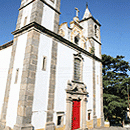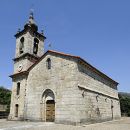Museums, Monuments and Sites
Results
Number of results: 1327
-
 MonumentsSantuário do Senhor Jesus do BonfimSanctuary of Senhor Jesus do Bonfim On the way out of Portalegre, on the road to Castelo de Vide and Marvão, there is the Sanctuary of Lord Jesus of Bonfim, also known as the Church of Bonfim. Its construction was ordered in 1720 by bishop Álvaro (...)
MonumentsSantuário do Senhor Jesus do BonfimSanctuary of Senhor Jesus do Bonfim On the way out of Portalegre, on the road to Castelo de Vide and Marvão, there is the Sanctuary of Lord Jesus of Bonfim, also known as the Church of Bonfim. Its construction was ordered in 1720 by bishop Álvaro (...)
-
 MonumentsIgreja de São Miguel ArcanjoChurch of São Miguel Arcanjo The Church of São Miguel Arcanjo was commissioned in the 15th century. Remnants from this period include the Gothic doorway in the façade.The church has three naves, with a Gothic triumphal arch, and gilded woodwork and (...)
MonumentsIgreja de São Miguel ArcanjoChurch of São Miguel Arcanjo The Church of São Miguel Arcanjo was commissioned in the 15th century. Remnants from this period include the Gothic doorway in the façade.The church has three naves, with a Gothic triumphal arch, and gilded woodwork and (...)
-
 MonumentsCastelo de LongroivaThe castle is an old fortification of the Knights Templar that was restored by Gualdim Paes. There still remains a tower and walled enclosure that functions as a cemetery.
MonumentsCastelo de LongroivaThe castle is an old fortification of the Knights Templar that was restored by Gualdim Paes. There still remains a tower and walled enclosure that functions as a cemetery.
-
 MonumentsSantuário do Senhor do SocorroSanctuary of the Senhor do SocorroThe patron of the building of the Sanctuary was a Brazilian, probably in order to fulfil a promise.The church was built in 1773 and has a single nave, a main chapel and a rococo façade with two towers. The site (...)
MonumentsSantuário do Senhor do SocorroSanctuary of the Senhor do SocorroThe patron of the building of the Sanctuary was a Brazilian, probably in order to fulfil a promise.The church was built in 1773 and has a single nave, a main chapel and a rococo façade with two towers. The site (...)
Telephone: 258941053
-
 MonumentsIgreja do Salvador de Ribas
MonumentsIgreja do Salvador de Ribas
Telephone: +351 255 810 706
Fax: +351 255 810 709
E-mail: rotadoromanico@valsousa.pt
Website: http://www.rotadoromanico.com
-
 MonumentsVigia do FachoA watch tower which was part of the system for defending the entrance to the Tagus estuary.The tower is in a poor state of repair, but maintains its original structure and is classified as a building of public interest.
MonumentsVigia do FachoA watch tower which was part of the system for defending the entrance to the Tagus estuary.The tower is in a poor state of repair, but maintains its original structure and is classified as a building of public interest.
-
-
 MonumentsConvento de São Miguel - ÓbidosThe Convento de São Miguel das Gaeiras, a Franciscan monastery, was founded by Prince Henry the Navigator, the son of Dom Manuel I, in 1569, and transferred to its current site in 1602.Today, it displays signs of having been harmoniously restored to (...)
MonumentsConvento de São Miguel - ÓbidosThe Convento de São Miguel das Gaeiras, a Franciscan monastery, was founded by Prince Henry the Navigator, the son of Dom Manuel I, in 1569, and transferred to its current site in 1602.Today, it displays signs of having been harmoniously restored to (...)
-
-
 MonumentsIgreja de Santa Maria de AzuraraChurch from the 16th c. in manueline style.
MonumentsIgreja de Santa Maria de AzuraraChurch from the 16th c. in manueline style.



